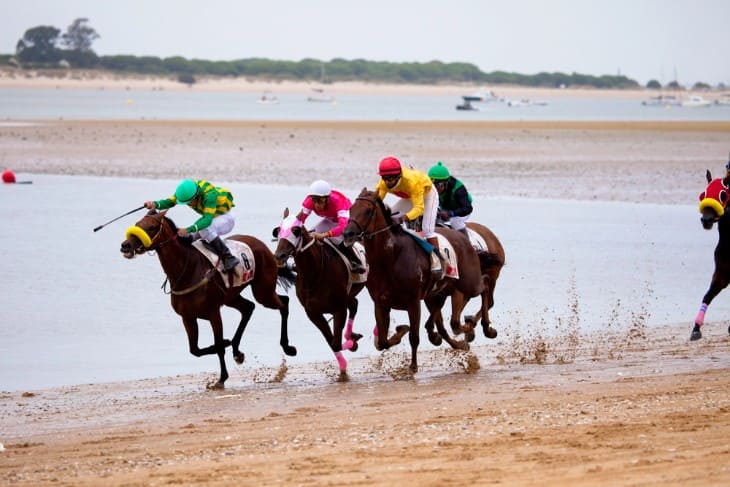- Defining the Dam: The Maternal Powerhouse in Horse Racing
- The Genetic Influence: How Dams Shape the Future of Racehorses
- Dams and Their Legacy: Creating Racing Dynasties
- Beyond Genetics: The Role of Care and Nurturing
- The Business of Breeding: Dams as Valuable Assets
- Dams in the Spotlight: Famous Matriarchs of the Racing World
- The Science of Selection: Breeding Strategies Involving Dams
- The Future of Racing: Dams and Innovative Breeding Techniques
- Dams and Pedigree Analysis: Tracing Lineages for Success
- Final Verdict
In the fancy world of horse racing, a lot of people talk about the male horses, their families, and how good they are at racing. But, the female horses, called "dams" (which means they are the mums of racehorses), are just as important in creating future racing stars.
Knowing about dams and how they affect horse racing is really important if you're into breeding and racing these amazing animals.
Defining the Dam: The Maternal Powerhouse in Horse Racing
In the world of horse racing, a dam isn't just a racehorse's mum. She's super important for the sport, playing a big part in making racing families that do really well. Let's talk about what a dam is and why she matters so much in horse racing.
Basically, a dam is the mum of a racehorse. When it comes to breeding, her job is to pass on her good qualities to her babies. This can be stuff like how fast she can run, how long she can keep going, and even her personality, like if she's calm or really tough. Picking the right dam is a big deal because what she's like can really affect how good her foals (baby horses) are at racing.
But it's not just about the genes she gives her foals. She also looks after her babies when they're really young, teaching them how to behave with other horses. This early care is super important for making sure a racehorse grows up healthy and knows how to act properly.
In horse racing, people really care about a dam's family tree. If she was a great racer or comes from a family of winners, her babies are going to be pretty popular. They're seen as the next big stars, ready to carry on their mum's winning streak.
Breeders also keep an eye on how a dam's other babies have done in races. If she's had winners before, lots of people will want her next foals. How good her babies turn out can make a big difference to racing teams and decide what breeders do next.
The Genetic Influence: How Dams Shape the Future of Racehorses
The genetic influence of a dam is a crucial factor in shaping the future of racehorses. It's not just about physical traits; dams also pass on a blend of characteristics that are vital for racing success. Here's how they contribute to the future of their offspring:
- Physical Traits: Dams pass on key physical attributes to their foals. This includes aspects like size, bone structure, and muscle composition. These traits are fundamental for a racehorse's speed and endurance on the track.
- Temperament and Behaviour: The temperament of a dam is often inherited by her offspring. Qualities like intelligence, calmness, and adaptability are important in the high-stress environment of racing. A dam with a good temperament can pass this trait on, giving her foals an edge in their training and performance.
- Stamina and Resilience: Stamina and resilience are essential for a racehorse, and these traits can be strongly influenced by the dam. Her ability to endure long races and recover quickly can be mirrored in her offspring, contributing to their racing prowess.
- Health and Longevity: The overall health and longevity of a dam play a part in her foals' future. Dams with a history of good health and longer racing careers often pass these beneficial traits to their offspring, increasing their chances of a successful and sustainable racing career.
Dams and Their Legacy: Creating Racing Dynasties
Dams play a super important part in creating families of racing stars, leaving a big mark on horse racing. They do a lot more than just have baby horses; they pass on special qualities that can really shape the future of racing teams.
First off, if a dam's kids do really well in races, becoming winners or even champions, she becomes a star in the world of horse breeding. Her ability to give her babies those winning streaks is what starts a racing family that can last for ages. It's not just about having one or two good racers; it's about always having great racing horses come from her.
Some mums get famous because they have lots of kids that win races, sometimes in different types of races. Being able to have lots of top-notch racers is what makes these dams stand out and be remembered in horse racing.
These superstar mums are super valuable for breeding. Not just their kids, but even their grandkids can end up being winners, thanks to the great qualities they inherit. That's why racing teams really want horses that come from these special dams; their families can keep winning races for a long time.
Also, a dam that has a bunch of successful racers can make a racing team look really good. She shows everyone that this team has high-quality horses, which can bring in more people wanting to breed with their horses or invest in the team.

Beyond Genetics: The Role of Care and Nurturing
While genetics play a crucial role in shaping racehorses, the care and nurturing they receive, especially from their dams, are equally important. The early life experiences of a foal can significantly impact its development and future success in racing.
- Early Bonding and Development: The bond between a mother and her child in the early stages is vital. During this time, the dam teaches her foal essential behaviors. This bonding period sets the foundation for the foal's future social interactions and behavior.
- Nutrition and Health: The health of a foal is greatly influenced by the care it receives from its dam. Proper nutrition, is essential for the development of strong bones and muscles, especially in the early stages of life. A dam's ability to provide for her foal impacts its overall health and growth.
- Stress Management: Foals learn to handle stress from their dams. A calm and composed dam can help her foal develop a stable temperament. This is particularly important in the high-pressure environment of horse racing, where horses must remain calm and focused.
- Learning through Observation: Foals often learn by observing their dams. This includes everything from basic movements to more complex behaviors. A dam's interaction with her surroundings and handlers also offers learning opportunities for the foal.
The Business of Breeding: Dams as Valuable Assets
In the horse racing industry, dams are more than just maternal figures; they are significant assets in the business of breeding. Their value lies not only in their own achievements and genetics but also in the potential of their offspring.
- Breeding Rights and Value: The breeding rights of a successful dam can be highly lucrative. If a dam has a history of producing winning racehorses, her value in the breeding market increases significantly. Breeders and investors are willing to pay premium prices for the opportunity to breed with such a dam.
- Influence on Sales and Auctions: The offspring of a well-regarded dam often command high prices at sales and auctions. Buyers are attracted to foals from successful maternal lines, anticipating that they too will be high performers on the track.
- Strategic Breeding Decisions: Choosing the right dam is a strategic decision in the breeding process. Breeders carefully consider a dam's pedigree, racing history, and previous offspring's success. A dam with the right combination of these factors can be a game-changer for a breeding program.
- Long-Term Investment: Investing in a quality dam is a long-term strategy. Her influence extends over several generations, making her a key contributor to the stable's future success. Her genetic legacy can shape the quality of the racing team for years to come.
Dams in the Spotlight: Famous Matriarchs of the Racing World
In the racing world, certain dams have achieved legendary status, known for their remarkable contribution to the sport. These matriarchs have not only excelled in their own right but have also produced offspring that continued their legacy of excellence on the racetrack.
- Urban Sea: One of the most famous matriarchs in horse racing history is Urban Sea. She won the 1993 Prix de l'Arc de Triomphe and went on to produce several successful racehorses, including the renowned Galileo and Sea The Stars.
- Somethingroyal: Known for producing the legendary Secretariat, Triple Crown winner in 1973, Somethingroyal left a significant mark in horse racing. Secretariat's extraordinary success on the track is a testament to her genetic legacy.
- Miesque: A remarkable racehorse in her own right, Miesque became equally famous as a dam. She produced Kingmambo, a successful sire, and several other high-performing racehorses, solidifying her status in the racing world.
- Hasili: Another influential dam in thoroughbred racing is Hasili. She is known for producing a remarkable five Group 1 race winners, including Banks Hill and Intercontinental, making her one of the most successful broodmares in history.
These famous dams have not only excelled in their maternal roles but also significantly influenced the sport's breeding patterns. Their offspring have gone on to win major races, set records, and become successful sires and dams themselves.
The Science of Selection: Breeding Strategies Involving Dams
Breeding racehorses is a science that involves careful selection and strategic pairing, especially when it comes to choosing the right dam. The process is not just about picking any successful racehorse as a dam; it's about understanding her genetic makeup and how it can complement the sire's traits.
Here's a closer look at how breeders select dams for producing champion racehorses:
When breeders want to find out if a female horse (we call her a dam) will have fast and strong baby horses, they start by checking out her family tree. This helps them see what kind of racing skills or health issues might run in the family and any special things about her relatives that stood out.
Next, they look at how the dam looks and acts. Things like how big she is, her body shape, and if she’s generally healthy are important. They also think about her personality. If she’s smart and stays calm under pressure, that's a good sign because she might pass these cool traits onto her babies.
If the dam has raced before, they see how well she did. Her racing results can show if she's got a lot of stamina, speed, and toughness. Plus, if she’s had baby horses before, seeing how those offspring did in races can give clues about how her future babies might perform.
Choosing the right dad horse (called a sire) for her babies is a big deal too. Breeders look for a sire that goes really well with the dam, maybe making up for any areas she’s not as strong in or making her good points even better.
They also make sure to keep things mixed up genetically. This means they avoid breeding horses that are too closely related, which helps keep the baby horses healthy.

The Future of Racing: Dams and Innovative Breeding Techniques
The future of horse racing is increasingly shaped by innovative breeding techniques, with dams playing a central role. These advancements are enhancing the way breeders select and breed dams, leading to a new era in racing.
- Genetic Testing and Analysis: One of the key innovations is genetic testing. This allows breeders to understand a dam's genetic makeup in detail, predicting her ability to pass on desirable traits to her offspring. It helps in making informed breeding decisions, matching dams with sires that complement their genetic strengths.
- Artificial Insemination and Embryo Transfer: These techniques offer new possibilities in breeding. Artificial insemination allows for the selection of sires from a global pool, broadening the genetic diversity. Embryo transfer lets a valuable dam produce multiple offspring in a year, increasing her impact on the sport.
- Data-Driven Breeding Decisions: Advanced software and databases provide breeders with extensive data on pedigree, racing performance, and health records. This wealth of information supports more strategic breeding choices, focusing on producing stronger, faster, and more resilient racehorses.
- Preservation of Genetic Diversity: With these technologies, there's a greater focus on preserving genetic diversity within the racing population. This is crucial for the health and longevity of racehorses, ensuring the sport's sustainability.
The role of dams in this evolving landscape remains crucial. They are not just carriers of future champions but are integral to the genetic advancement of the sport. With innovative breeding techniques, the potential of these matriarchs is maximized, promising an exciting future for horse racing.
Dams and Pedigree Analysis: Tracing Lineages for Success
In horse racing, figuring out a horse's family tree, especially the mum's side, is really important. It helps people guess how good her baby horses might be in races. It's not just about knowing who her relatives were; it's about really getting into the details of what made them special in racing.
When people look at a mum horse's (dam's) family history, they're checking out things like how fast they were, how long they could run without getting tired, and how tough they were. They also look out for any health problems that seem to run in the family or any special traits that could make her babies great racers.
They also take a good look at the mum's own racing history and how any of her babies have done in races before. If she's had some really fast and strong babies, there's a good chance her future babies will be great at racing too. Breeders really pay attention to whether she keeps having top-notch babies and how they do in different kinds of races.
There's also a bit of matchmaking involved. Breeders try to find a dad horse (sire) that goes really well with the mum, hoping their baby will get the best traits from both. This careful choosing is all about trying to breed baby horses that could grow up to be even better racers than their parents.
Final Verdict
In conclusion, the role of dams in shaping racing dynasties and the broader equestrian world is invaluable. From genetic contributions to early nurturing, their impact is profound and far-reaching. Understanding and honouring the role of the dam is essential in appreciating the intricacies of horse racing and breeding.
As the industry continues to evolve, the importance of dams remains a central and enduring theme, a tribute to their indispensable contribution to the legacy and future of horse racing.








